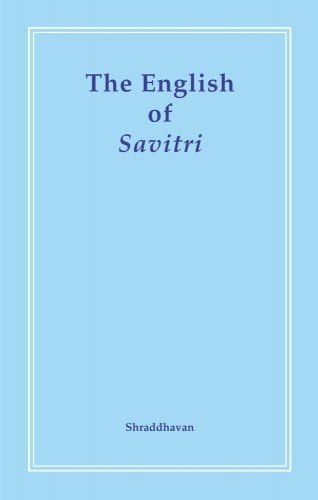Солнечная тропа

Солнечная Тропа
«Не принимайте мои слова за учение. Они всегда являются силой в действии, используемой с определенной целью. Они теряют свою силу, когда от этой цели отдалены.» — Мать

«Не принимайте мои слова за учение. Они всегда являются силой в действии, используемой с определенной целью. Они теряют свою силу, когда от этой цели отдалены.» — Мать

Книга «Основы йоги» Шри Ауробиндо представляет из себя сборник выдержек из различных писем Шри Ауробиндо своим ученикам, в которых он отвечает на их вопросы. Эти отрывки собраны вместе и выстроены так, чтобы оказать некую по мощь стремящимся понять и практиковать Интегральную Йогу.
«Эта Йога требует, чтобы вся жизнь без остатка была посвящена исключительно стремлению раскрыть и воплотить Божественную истину. Недопустимо делить свою жизнь между Божественным и какой-то иной целью и деятельностью, не имеющей ничего общего с поиском Истины. Наималейшее поползновение такого рода обрекло бы Йогу на неудачу.» — Шри Ауробиндо

Since 1980, Shraddhavan has been teaching English in Auroville through close readings of Sri Aurobindo’s revelatory epic Savitri: a legend and a symbol. In August 1998 these classes were resumed at Savitri Bhavan, with a growing number of students, including young Tamil teacher-trainees from the Arul Vazhi School located in Promesse, Auroville. These classes were given the name ‘The English of Savitri’ and they concluded in May of 2009 as this group reached the end of the poem.
This book is based on the transcripts of a new series of classes given by Shraddhavan between August 2009 and October 2010, which have been edited for conciseness and clarity, while aiming to preserve some of the informal atmosphere of the course. Edited transcripts of these classes began to be published serially in the Bhavan’s journal of Study Notes on Savitri, ‘Invocation’, from issue 32 onwards, since it was felt that they may be of interest to a wider audiance. They are now being published in book form in several volumes by Yukta Prakashan publishers of Vadodara. This suggested the idea of collecting the original English articles into a book form as well. This is the first such volume, covering all the five cantos of Book One of the poem, ‘The Book of Beginnings’.

Broad overview of psychology, cosmology and transformational practice of Integral Yoga – a psychological and spiritual methodology for evolutionary transformation of human nature developed by Sri Aurobindo. In 3D motion graphics.
Man is a transitional being…
A psychological and spiritual methodology for evolutionary transformation of human nature.
Psychology
We mean by psychology the study of the psyche (ψυχή) following yogic methodology. It is different from the academic and applied discipline of psychology as it emerged in the West over the last 100 years, involving the scientific study of mental functions and behaviors. The fundamental difference in methodology also leads to very different orientations, discoveries and consequences.
Cosmology
We are presenting here not the cosmology of the physicists but the cosmology as mapped by Sri Aurobindo following the methodology of Integral Yoga. In this view, consciousness is the most fundamental thing in existence and the exploration covers the full spectrum of consciousness and its evolutionary process.
Transformational Practice
Integral Yoga is a methodology Sri Aurobindo developed for not only exploring the profound depths and heights of human psyche but also for an integral evolutionary transformation of the human nature. Here we give a broad overview of the process leading towards psychic, spiritual and supramental transformation.

by Nishtha Müller
The inspired poetic Word was the means of passing on knowledge and experience by the Vedic Seers and by Sri Aurobindo, especially in his epic Savitri. What do the Vedic seers and Sri Aurobindo in their poetic creations themselves tell us about the Word, its nature and usage?
At the outset it must be said that this study is not exhaustive and does not intend to cover all relevant passages either from the Veda or from Savitri. Its central idea is simply to make potential readers more conscious of the great value of these mantric texts and point out a possible way to approach these divine gifts to aspiring humanity. In regard to the Veda it must be said right from the outset that there exists the special barrier of the Sanskrit language in general and the multi-layer meaning of Vedic terms in particular.[1] In addition there is the all-pervasive Vedic symbolism. Sri Aurobindo often calls the Vedic Rishis “symbologists” and refers back to the period of the composition of the Vedic hymns both as the age of symbolism and the age of intuition. In fact Sri Aurobindo also makes much use of symbolism. In this study we will see that the Veda and Savitri shed light on each other in their symbolism.
But let us first ask the general question: what do the Veda and Savitri have in common? They are both mystic mantric poetry of the highest order. Sri Aurobindo refers to the Veda – certainly among Indian literature and scriptures, and perhaps even beyond – as “our supreme poetry”[2] They both bring forth an integral vision of reality and transmit it as revelatory knowledge and verifiable experience (and that does not exhaust the subject.)
What is the basic difference between them? Savitri, in its outer form, is one single epic poem written by one sole author, whereas the Rig-Veda consists of a collection (samhita) of more than one thousand hymns (suktas, meaning perfect utterances) of many different seers, spanning a time of at least several centuries. Even though some of the Suktas are made up of a considerable number of verses or stanzas they generally do not reach the length of any of the cantos which we find in the twelve books of Savitri. From that point of view one could say, with a few exceptions, that the Vedic hymns are even more concise than any paragraph in Savitri. Still, all Vedic hymns presume a common background, and many of them are related to the same theme but present it from different standpoints, a practice which we also find within the different books of Savitri.
It is a known fact that Sri Aurobindo in Savitri makes abundant use of Vedic imagery as the carrier of his knowledge and experience. It might be worthwhile to remember in this context that in the period from 1912 up to perhaps 1920 Sri Aurobindo was studying and writing on the Veda on an almost daily basis, and also translated hundreds of its hymns into English. Among other reasons, it could have as well been due to this preoccupation with the Book of Mantra (the traditional name given to the Veda) that Sri Aurobindo conceived the idea to do something of the kind – even though in a different form – for the present age in the much more easily accessible English language. At the same time we should not forget the fact that already before this period Sri Aurobindo was an accomplished poet and seer. But, knowing on one hand how central is the usage (and its constant mentioning in hymn after hymn) of the inspired Word to the Vedic seers, and on the other hand how much and in detail Sri Aurobindo writes about this fact in “The Secret of the Veda”[3], one could still dare the thought that it might have inspired him to do something similar.
Books published in Sri Aurobindo Ashram. The Ashram is a large community reflects the life-affirming aim of Sri Aurobindo’s Yoga.

Born in Tanzania (1926); graduated in philosophy from the University of Poona, India (1950); lived as an inmate of Sri Aurobindo Ashram, Pondicherry (1952-59); studied psychology at the University of Poona (1959-61); pursued studies in clinical psychology and received training in psychotherapy and psychoanalysis in the United States (1964-70); worked in the United States in different positions until 1985; residing in Pondicherry since 1986, engaged chiefly in research and writing.
To date has written three books on Sri Aurobindo’s psychological thought as well as a book comparing some aspects of Eckhart Tolle’s teaching with Sri Aurobindo’s yoga; has also compiled twelve books (one currently in the press) based on the works of Sri Aurobindo and the Mother.


This little booklet is a powerful triplet of essays first published by Sri Aurobindo in the monthly review Arya in 1915. In his splashing poetic prose, Sri Aurobindo first describes his Superman against the backdrop of the Nietzschean overman and public misconceptions. He then goes on to hammer out the relationships between all-will, free-will and fate. At the last, he commands you to grasp the delight of works with his lilting voice of authority. All together, this little booklet is like a powerful vitamin B shot for the soul.
